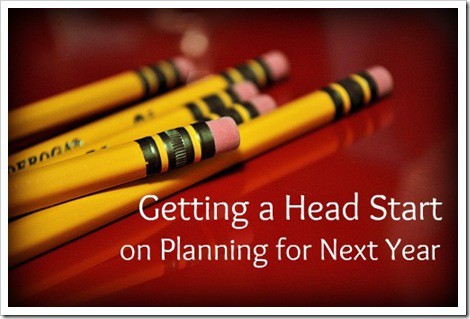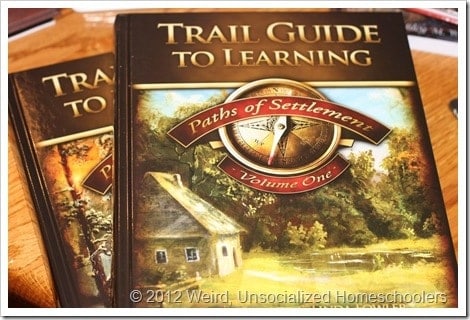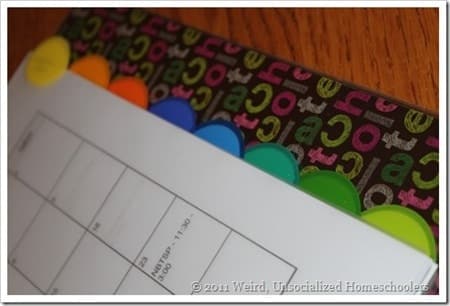Get a Head Start on Planning for Next Year
I confess, I’m not quite ready to start planning for our next school year – of course, since we’re trying year round schooling this year and starting the second week of July, I’m going to have to think about it soon.
I know some of you school year round and have already started, but others probably aren’t starting until August or September. If you’ve got a couple of months before you start your next school year, it’s not too early to get a head start on planning.
You don’t have to do any heavy-duty planning yet, but there are four simple steps that you can take right now to lay the right foundation for a great school year next year.
1. Assess. Think back over the last year and answer a few key questions:
- What worked really well?
- What could have gone better?
- What needs to be tweaked?
- What could use a complete overhaul?
- What fell by the wayside? Of those, which ones need more focused attention this year? Which ones don’t need to be picked back up? Which ones are fun extras that you want to include to some extent?
Answering these questions will help you bring your academic and curriculum needs into sharper focus, so you can begin to decide what your school day is going to look like in the upcoming year. It will also help you figure out which curriculum needs to be tweaked or replaced and which will find its way back into the lineup.
2. Reflect. Our state, Georgia, requires that parents write an annual progress report for each child. These reports don’t have to be turned in to anyone, but must be kept on file for three years. (Yeah, it doesn’t make sense to me either.)
One of the things that I really like about writing these progress reports is that it helps me to reflect on my kids’ progress. Sometimes, in the day-to-day, you don’t notice the steady progress – particularly in your child’s area of struggle.
However, when you look back to where your child was at the beginning of the year and see where he is now, you can often see more progress than you initially realized. Writing a progress report, even if you’re not required to, can be one way to assess your homeschooled child’s progress.
3. Ask. Get your kids’ input. Ask them what they liked best and what they liked least. Find out what they remember most from the school year and what made it so memorable.
Maybe it was the hands-on projects that stuck out in their minds. That might mean that you have a kinesthetic learner who would enjoy more hands-on activities. Perhaps it was a writing assignment that your wordsmith dove into, letting you know that you need to plan for more creative cross-curricular writing opportunities.
Maybe it was a particular book, indicating that you might want to include more biographies, historical fiction, or quality literature in your school day.
Find out what pieces of curriculum your kids did and didn’t like. While kids do sometimes have to do things that they may not like, getting your child’s input may help you to pinpoint the curriculum that is the best fit for him or her.
If your child is old enough, you may allow him to pick out (or help you choose) his curriculum. Having this level of input can give your child a sense of ownership that will encourage him to put forth his best effort in the coming school year.
4. Plan. I like to have a basic skeleton for each school year. It’s helpful for me to plan out our school year calendar, so that I can make sure we’re staying on track to complete our state-required 180 days within our preferred timeframe (read: We have to be finished with the school year before my older daughter’s birthday in May.)
I don’t plug in exactly what we’re going to be doing when, but it does help to know which days are going to be school days and which are going to be holidays. It’s also helpful to be able to plan for known events, such as homeschool group activities, outside classes, extracurricular activities, vacations, and as many appointments as I know about at the time I sit down to plan (like those dental appointments you know about six months in advance).
Knowing which days we’ll be able to have a focused, at-home day helps me to know when to plan for lighter days versus heavier days.
These four steps – assess, reflect, ask, and plan – don’t require deep thought or in-depth planning, but they can really help sharpen your focus for the upcoming school year and make it easier when the time does come for more detailed planning.
If you do this type of pre-planning, what tips have you found helpful? How much planning do you do prior to the start of the school year?
Kris Bales is a newly-retired homeschool mom and the quirky, Christ-following, painfully honest founder (and former owner) of Weird, Unsocialized Homeschoolers. She has a pretty serious addiction to sweet tea and Words with Friends. Kris and her husband of over 30 years are parents to three amazing homeschool grads. They share their home with three dogs, two cats, a ball python, a bearded dragon, and seven birds.






Are you continuing with Paths of Settlement this year? This will be our second year homeschooling and have decided very little worked for us last year. We need a drastic change! My son will be in 7th grade and I keep wavering on POS….I decide to buy it then can’t hit the order button 🙂 We switched from MUS to teaching textbooks and will start it next week (we have decided to do math year round) and hope it will offer more help explaining math concepts than I can. 🙂
Yes, we are. We should finish POS by Christmas break and already have plans to begin POP in January. It’s really been a good fit for us.
I usually have most of my planning for the new year done by this point, but this year I’ve been a slacker!
I like to have a sheet with my goals for each subject as well as the basics of what we are going to cover for the year. This helps me see where we are going, plus I have to submit my goals to the state anyway. I also like to have the first quarter planned out in detail before we start the year. I’m a bit of a planning freak though :).